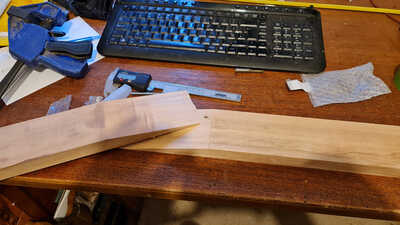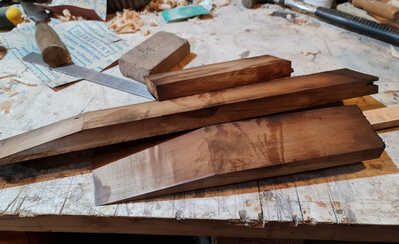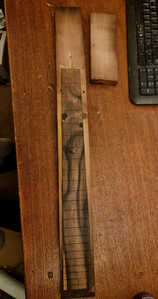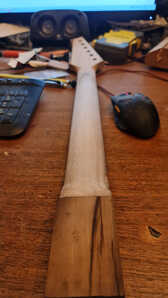Decided after a bit of googling to have a go at roasting some maple, did gas mark 5.5 for an hour or so then gas mark 7 for 30 minutes.
I cut a scarf joint so it'd fit in the oven lol
After roasting
And now I've done the trussrod channel and glued on a board. I'm going to go the whole way and actually make a neck, no idea if I'll use it but I'm curious to see how it'll turn out
I'm now thinking about a possible steel barrel or such that I can suck the air out of and stick on a bed of hot embers, put something inside to support the maple. I think it's generally done under vacuum which might be to stop the wood burning.
I'm now thinking about a possible steel barrel or such that I can suck the air out of and stick on a bed of hot embers, put something inside to support the maple. I think it's generally done under vacuum which might be to stop the wood burning.
Would that be a bit like making a jig then?
I do like you're inventiveness. I would be a bit reluctant to heat up a sealed steel tube though, we don't need another flying scotsman.
Happy new year all!
suck the air out of and stick on a bed of hot embers
Hi NSJ, embers will become very cold very quickly in a vacuum as there will be no oxygen to sustain combustion but I guess you are effectively talking about placing the evacuated tube on a low, smouldering bonfire. I think that it would be better to build in electric heating if you are planning to roast maple in a vacuum chamber although it’s not entirely clear to me why the vacuum would be advantageous (open to suggestions). However you roast the timber remember that you will then have to let it season in reverse to come back up to ambient moisture levels before you start to machine it if you want it to remain stable.
Cheers
Darren
@darrenking this is what I get when googling.
"How do they make roasted maple wood?
I was wondering what the advantages of a roasted maple neck would be, so did a bit of googling too and came up with this, https://myguitarlair.com/roasted-maple-guitar-neck/
- Improves tone of the wood (clearer and richer)
- Better tuning stability and intonation.
- Makes the guitar lighter.
- Increases sustain.
- More warp resistant.
- Prevents “fret sprout
I don't want to be negative so I'll not list the disadvantages or pitfalls, but I think that you're likely to get some random results with your simplified method. Having said that, if we don't try something different, then we'll never know.
I was wondering what the advantages of a roasted maple neck would be, so did a bit of googling too and came up with this, https://myguitarlair.com/roasted-maple-guitar-neck/
- Improves tone of the wood (clearer and richer)
- Better tuning stability and intonation.
- Makes the guitar lighter.
- Increases sustain.
- More warp resistant.
- Prevents “fret sprout
Here's me-the-cynic ...
Those are - mostly - relative advantages, ie improves, better, lighter, increases, more. So the question is relative to what?
TBH, I've never had a problem with fret sprout, nor warping necks. Any reduction in weight must be marginal against the overall weight of the instrument (similar to going down a string gauge, or cutting off the ends you left after winding them)! And I can't really rationalise the better intonation claim.
Unless the comparison is between a piece of maple that wouldn't really be suitable for use as a neck, and roasting it helps the stability.
So perhaps the benefit is in making an unsuitable piece of wood more suitable for use as a guitar neck?
Online guitar making courses – guitarmaking.co.uk
I can say this neck feels pretty light compared to a previous one made from the same wood not baked. I was mainly interested in the colour and stuff, heard plenty talk about it, thought I'd try it.
Regarding stability I think it would be good for highly figured wood like birdseye that in my experience can certainly warp! I've made about 11 necks and the birdseye is the only one that's warped on me
Regarding stability I think it would be good for highly figured wood like birdseye that in my experience can certainly warp! I've made about 11 necks and the birdseye is the only one that's warped on me
Ahhhh - I’ve never used anything other than fairly plain woods for necks, so never had that experience (thankfully!).
Online guitar making courses – guitarmaking.co.uk








